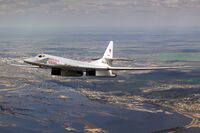Tupolev Tu-160 Blackjack
The Tupolev Tu-160 Belyy Lebed (Russian: Туполев Ту-160 Белый лебедь, translit. Belyy Lebed, lit. 'White Swan'; NATO reporting name: Blackjack) is a supersonic, variable-sweep wing heavy strategic bomber designed by the Tupolev Design Bureau in the Soviet Union. Although several civil and military transport aircraft are larger in overall dimensions, the Tu-160 is currently the world's largest combat aircraft, largest supersonic aircraft, and largest variable-sweep aircraft built. In addition, the Tu-160 has the heaviest takeoff weight of any military aircraft besides transports.
Entering service in 1987, the Tu-160 was the last strategic bomber designed for the Soviet Union. The aircraft remains in limited production, with at least forty-eight aircraft currently in service with the Russian Air Force.
Variants[edit | edit source]
- Tu-160: Production version.
- Tu-160S: Designation used for serial Tu-160s when needed to separate them from all the pre-production and experimental aircraft.
- Tu-160V: Proposed liquid hydrogen fueled version (see also Tu-155).
- Tu-160 NK-74: Proposed upgraded (extended range) version with NK-74 engines.
- Tu-160M: Upgraded version that features new weaponry, improved electronics and avionics, which double its combat effectiveness.
- Tu-160P (Tu-161): Proposed very long-range escort fighter/interceptor version.
- Tu-160PP: Proposed electronic warfare version carrying stand-off jamming and ECM gear (Russian: ПП – постановщик помех "staggering").
- Tu-160R: Proposed strategic reconnaissance version.
- Tu-160SK: Proposed commercial version, designed to launch satellites within the "Burlak" (Russian: Бурлак, "hauler") system.
- Tu-160M2: Highly upgraded version featuring new engines, avionics, electronics, glass cockpit, communications and control systems, and a number of weapons, as well as improved thrust and unrefueled range.
Users[edit | edit source]
- India
- Indian Air Force
- Russian Federation
- Russian Air Force (Currently)
- Soviet Union
- Soviet Union (Until December 25, 1991)
- Ukraine
- Ukrainian Air Force (Until 1999)

